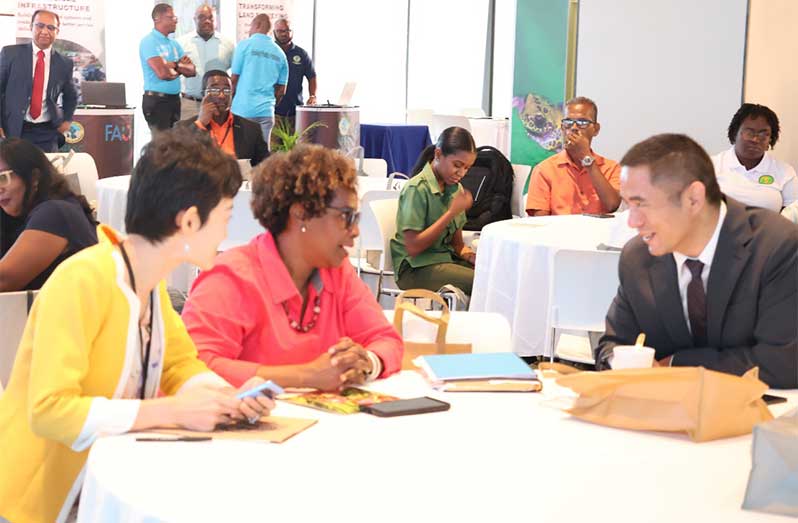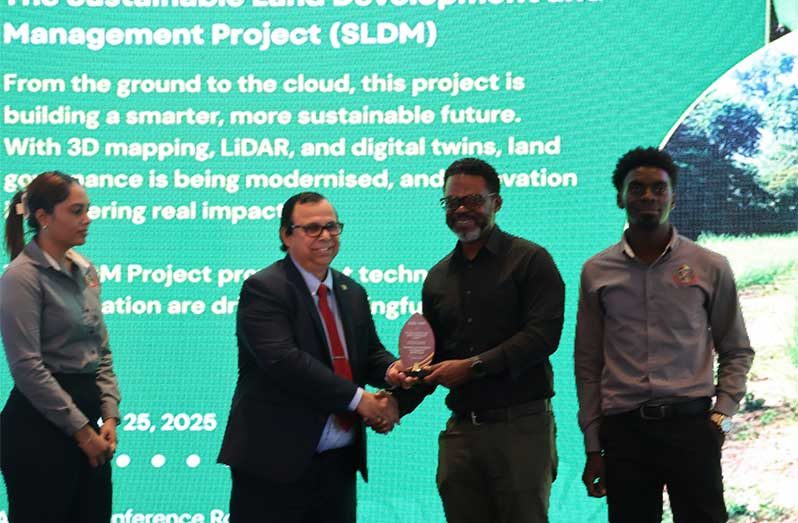GUYANA’S housing sector is undergoing more development than ever, with demand for housing at an all-time high, and so too are the systems surrounding land development and management.
This was revealed by Chief Executive Officer and Commissioner of the Guyana Lands & Surveys Commission, Enrique Monize, during the closing ceremony of the Sustainable Land Development and Management (SLDM) Project.

Speaking to guests at the event on Tuesday, Monize highlighted that some 30,000 requests have been made for land in the Soesdyke-Linden Highway area. As the commission continues to work on the distribution process, he said the heightened interest, coupled with the success of the SLDM project, reflects the blossoming growth of Guyana’s housing and land sector.
Monize described the growing number of housing requests as unprecedented in Guyana’s history, noting the provision of over 50,000 house lots which was supported by the commission.
“The commission has seen the largest demand from the public and completely processed in the approval stage approximately 9,000 applications for land for various purposes, various acreages, totalling over 150,000 acres.”
He added, “The demand is so much that we currently have over 30,000 requests, just simply requests, for land in one location.”
Moreover, he noted that the commission has made significant strides in responding to government requests, and has advanced work in policy, planning, technology, training and human-resource development. “We are proud to say that we have so far been able to deliver on almost all of the requests by government and in a timely manner.”
He added, “The commission saw the policies and plans of the government and decided that technology, training of a dedicated workforce and some amount of innovative planning were needed.”
Taking a deeper look at the SLDM project, Dr Gillian Smith, a representative of the Food and Agriculture Organization of the United Nations (FAO), said the initiative was pivotal in creating and enabling an environment for advancing sustainable land-management practices in Guyana.
By improving land-administration systems, streamlining land services and strengthening decision-making processes, she noted, the project has positioned Guyana to foster long-term economic, social and environmental development in keeping with the expanded Low Carbon Development Strategy 2030.
Through strategic collaboration between national institutions, regional and local bodies and international development partners, the project delivered major advances in technical capacity, data and information systems, institutional frameworks and operational practices.
“This joint effort not only enhanced our national capacities, but also laid the groundwork for a more resilient land management solution that aligns with national development priorities and global sustainability commitments,” she added. “The project stands today as a demonstration of what coordinated partnership, shared responsibility and sustained effort can achieve in promoting sustainable land management and safeguarding land resources for future generations.”
Dr Smith noted that the SLDM project has been years in the making, advancing steadily since 2018 despite major setbacks such as the COVID-19 pandemic. Throughout this period, she said, national partners worked together to deliver reforms, adding, “We have all worked together to deliver reforms and to deliver new technology, new ideas, new innovation in policy, geospatial modernisation and sustainable land restoration.”

Describing it as one of the most ambitious land-governance efforts undertaken in recent years, she highlighted its wide reach, engaging more than 20 national and regional agencies and training over 600 people including farmers, students, planners and technicians, contributing to what she called “a strong ecosystem for land governance.”
She explained that capacity building extended well beyond classrooms, with hundreds of Guyanese gaining hands- on skills. Under one component alone, nearly 100 farmers, 30 miners and almost 170 community actors were trained to assess land degradation and apply sustainable land-management tools. The project also drew on expertise from Brazil, Italy, Canada and across the Caribbean, supporting work in geology; LIDAR mapping; digital land administration; soil restoration and climate-smart agriculture, expertise that Dr Smith said has created impact that lasts.
According to Dr Smith, what truly defines the project’s success is that it strengthened and complemented Guyana’s own land-development agenda. “This project has been successful because of the national ownership,” she emphasised, crediting the leadership of the Guyana Lands and Surveys Commission for embedding innovations into long-term national systems.
Among the achievements she outlined were advances in geospatial infrastructure; digital transformation, including a next-generation lease system; institutional strengthening; upgraded equipment and improved access for more than 10,000 land users. Though the initiative officially closes on December 31, Dr Smith stressed, “The project comes to an end on the 31st of December this year, but the systems, the skills and the partnerships built through this project are laying the foundation for the next generation of land administration.”



.jpg)









